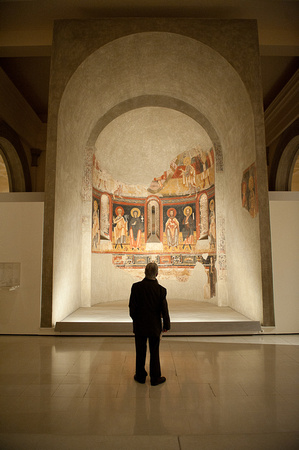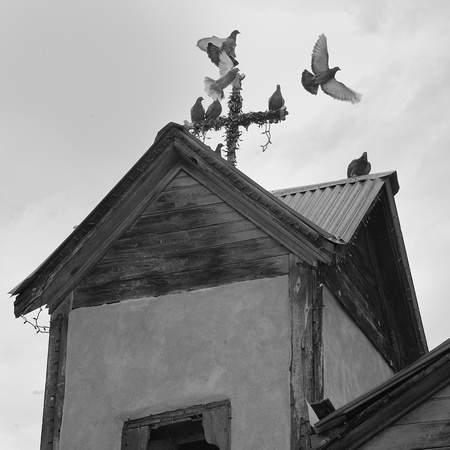 All artists have a certain style that defines the work they create and how they create it. Their way of seeing the world and conveying it in their art for the rest of us to enjoy. We either appreciate an artist’s style or we don’t. So before we get into all the good stuff, let me address this elusive concept of style. People ask me how they can develop their style, and I have come to the conclusion that you shouldn’t worry about it. Here’s why: You already have a style, and it is developing as we speak.
All artists have a certain style that defines the work they create and how they create it. Their way of seeing the world and conveying it in their art for the rest of us to enjoy. We either appreciate an artist’s style or we don’t. So before we get into all the good stuff, let me address this elusive concept of style. People ask me how they can develop their style, and I have come to the conclusion that you shouldn’t worry about it. Here’s why: You already have a style, and it is developing as we speak.That’s right: Just as you already have a personality, you already have a style all your own. Of course, your style will change as you mature, as your view of the world changes, and as you develop your craft, hone your skills, and gain further insight and knowledge of the art form you are embracing. We are all unique, and we all naturally make different statements in life. The same will be true of your art. Your style will be evident as long as you are not copying someone else’s style. Don’t try to be someone else.
Our personality develops from our experiences, our surroundings, and our interaction with life as we pass through it. From the relationships we choose to have and the people that influence us. It is who we are when we just “are.” Your style develops in much the same way. You don’t seek to develop your personal- ity, and I don’t think you need to seek to develop your style, either. It just develops. You interact with the world through your personality, and your style is pretty much the same: It is how you interact with the world through your art.
I suppose the core of all of this is to be true to yourself. We are continually learning new things and finding new ways to employ that knowledge in our craft. We stretch ourselves and sometimes do things that may not feel natural. Just make sure that even when you’re on the edge, you are always being yourself. You were fearfully and wonderfully made by One whose works are wonderful in ways we can’t begin to imagine. Rest in the vision that He has for you, and your style will be obvious, unique, and magnificent.

There has long been debate as to whether photography is actually art. I suppose believing it is not is easy to understand if you think of photography as simply holding a camera and pushing a button, but I am pretty sure that even now, in the first chapter of this book, you may be realizing that this is not the case at all. The art that is photography is quite obvious when the world is seen through the lenses of some of the pillars of photography, like Ansel Adams, Alfred Stieglitz, or Edward Weston, as well as any number of great contemporary artists like Jack Dykinga or Annie Leibovitz. These photographers and thousands more like them have made an art form out of seeing the world in a certain way and then conveying that vision to their audience. Although we will be putting great emphasis on the tools of photography, it will become very obvious that most of what makes photography art takes place in the eyes of the artist: you—the photographer.
 It is amazing to me what even the most affordable of cameras can do these days. All kinds of scene and face recognition, image stabilization and built in HDR effects just to name a few. Another feature where there have been enormous advances is in the area of low light/ high ISO performance. This has gotten so good that people find that they can hand hold and get a shot that would have normally required a tripod in some really low light situations. That is all well and good, but there are still times when you really do need a tripod.
It is amazing to me what even the most affordable of cameras can do these days. All kinds of scene and face recognition, image stabilization and built in HDR effects just to name a few. Another feature where there have been enormous advances is in the area of low light/ high ISO performance. This has gotten so good that people find that they can hand hold and get a shot that would have normally required a tripod in some really low light situations. That is all well and good, but there are still times when you really do need a tripod.
The image of the pennies at right is such a shot. It was shot with a 105mm f2.8 macro lens, and the exposure time was 30 seconds. This falls pretty much outside the boundaries of what most of us would consider a hand held shot. So yes, it required a tripod.
Macro photography has very limited depth of field, so to get the amount of focus I did in this shot, I had to stop down to f20. Even stopped down that small, you can still see that focus drops off by the time we get 2 or 3 coins down. Very shallow indeed!
So yes, the need for a tripod in modern photography has certainly been reduced, but not eliminated. Especially when we consider that the new batch of cameras are getting really high resolution sensors. This is requiring artists to almost shoot as if they were shooting medium format and that approach has a whole different set of concerns. Then you not only use a tripod, but you wonder if the mirror slap is going to blur the image.
What is old is new again...
 This is a pretty well known saying for photographers, but it bears repeating every chance we get. What is the best camera in the world? ... the one you have with you.
This is a pretty well known saying for photographers, but it bears repeating every chance we get. What is the best camera in the world? ... the one you have with you.
Yes, I know. It seems so obvious, but we often forget that we have a camera with us almost all the time. Specifically our cell phones.
This image of the church door at left was taken in Nashville with my iPhone 4. It is not of the same quality that I would get using my Nikon D800, but I did not have the Nikon with me. If we only take pictures when we have what we think is the right camera, we will miss out on a lot of images. This image may or may not be useable, but it is infinitely more useable than the picture I didn't get with my Nikon!
The story I share with folks in my workshops is of a really special birthday I threw for my wife. One of the the things we did was a helicopter tour of Long Beach and Los Angeles. The port of LA, Santa Monica pier, Downtown, Hollywood Blvd, Hollywood Bowl, Hollywood Sign etc. I spent that whole flight wishing I had a video camera with that same iPhone on my belt. As you may or may not know, it shoots pretty ok HD video!
I would have been well served to remember that I was carrying the best camera in the world with me.....
 Have you heard that term before? Catchlights? Once you have them pointed out to you, you will never be able to ignore them again.
Have you heard that term before? Catchlights? Once you have them pointed out to you, you will never be able to ignore them again.
Catchlights are the lights that appear in your subjects eyes when you are using a flash or there is a natural light source in just the right spot to produce them. They are what make eyes come alive in portraiture and they are hardly ever accidental.
As you can see in the close up of Loriann's eye, there are a couple of light sources that are quite obvious. On the left is a shoot thru umbrella and on the right is a square soft box. People don't usually notice these, but now that they have been pointed out to you, go look at some of the fashion shots of models in some of your favorite magazines. Getting those eyes to sparkle has a lot more to do with the photographer than you might have thought!

Excerpt from Photography in Worship … the art and science of iconic imagery.
Snapshots are the pictures we take to remember a moment in time. A vacation or a birthday party. Christmas at Mom’s or your daughter’s graduation. There are an infinite number of reasons why someone might want to take a picture to remember a moment in time, and there are cameras made to do just that. We want these cameras to do the hard work for us. We never want to miss a shot because we were tinkering with something on the camera, trying to make it work. Point-and-shoot cameras take great snapshots. Even if you are the most amazing photographer on the planet, with all the latest and greatest camera gear, you will probably want one of these cameras in your pocket or purse so you can just point and shoot, and capture that moment forever.
reasons why someone might want to take a picture to remember a moment in time, and there are cameras made to do just that. We want these cameras to do the hard work for us. We never want to miss a shot because we were tinkering with something on the camera, trying to make it work. Point-and-shoot cameras take great snapshots. Even if you are the most amazing photographer on the planet, with all the latest and greatest camera gear, you will probably want one of these cameras in your pocket or purse so you can just point and shoot, and capture that moment forever.
So why am I differentiating between a snapshot and a photograph? I suppose what I am actually addressing here is the intent behind the image. Of course a photograph can do all the same things that a snapshot can do, but I tend to believe that a lot more thought and planning goes into a photograph. There is a sense of the desired image when composing and taking a photograph that really doesn’t exist in what I would call a snapshot. There is a sense of art in the photograph.
The difference between snapshots and photographs is why even pro shooters will often carry a small pocket camera with them to grab shots without having to put a lot of thought into what needs to happen with the camera. The truth is that many of the elements of composition will remain the same no matter what you are shooting with, and great photographers will get great shots with a disposable camera, if that is what they happen to be holding. The goal of a great point-and-shoot camera, and ultimately a great snapshot, is this: you want it in focus, you want it exposed correctly, and you don’t want to have to think about it. That is why they are called “point and shoot” cameras, after all.
When taking a photograph, on the other hand, photographers will tend to want a camera that does less of the thinking for them, giving them direct control over the parameters and tools of photography. They want to directly influence what the camera is doing. In reading this book, you will discover the incredible amount of control you have over your camera, and how a shot will ultimately turn out. The downside is that the less the camera does for you automatically, the more you will need to understand the science of what is taking place. You will need to understand how to manipulate your camera’s controls and settings.
Don’t let the word “science” scare you. The subtitle of this book is “The art and science of iconic imagery,” and the entire point is to show you that for every artistic demand a shot places on you as a photographer, there is a tool on your camera that will let you achieve it. These tools allow you to interact with your camera and control how it will respond to the scene laid out before you. In this book you will learn to craft your art through a command of these tools.